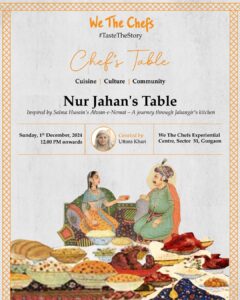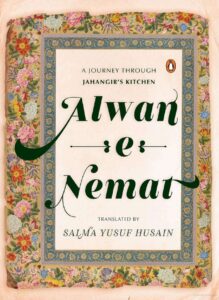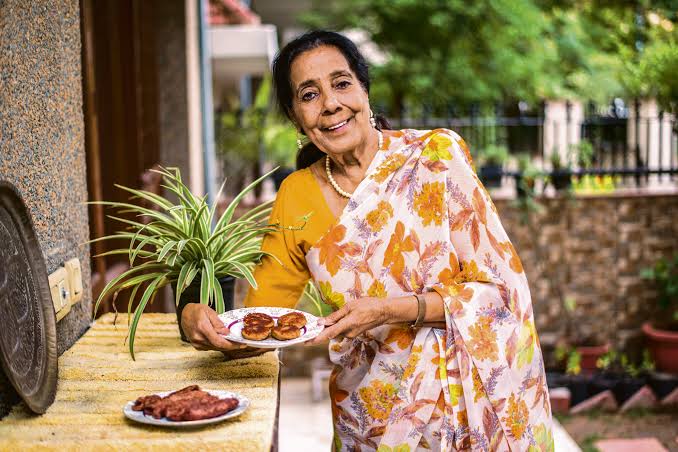This edition of ‘Food Talk with Sourish Bhattacharyya’ is different – and special – because it is not about a home chef. Instead, we invited Salma Hussain, food historian and author of the recently published translation of ‘Alwan-e-Nemat’, a Persian cookbook dating back to the reign of the Mughal Emperor, Jahangir.
Some of the recipes from the book, which belong to an age when chillies, potatoes and tomatoes (core ingredients of the food we eat today) hadn’t yet come to India, were recreated with precision into a creative Chef’s Table menu not long ago by Uttara Khan (https://www.youtube.com/watch?v=8bN60khzKj8), who literally melded a bygone era into the present at the We The Chefs Experiential Centre in Gurugram, Haryana.

Salma Apa, as she’s lovingly known, spoke about her journey from her graduation – she has a Master’s degree in Persian from the University of Bombay – to her induction into the National Archives of India, where she translated the correspondence in Persian of the nawabs of princely states with British agents and officials. From the National Archives, Salma Apa moved to the Union Ministry of Education, where she delved into Persian manuscripts from the Mughal era for the ‘Gazetteer of India’, and from there to All India Radio on the invitation of one its most-remembered bosses, P.C. Chatterjee, who made her responsible for shoring up the Persian services targeted at audiences in Afghanistan.
As she dived deeper into the world of Persian manuscripts, which were produced in plenty for official use when the Mughals (or the Timurids) ruled India, Salma Apa got interested, as she recalled during her conversation, in the idea of digging out information about the Mughal table. Her reasoning was simple: The Mughals have left behind so many national treasures, starting with the Taj Mahal and Delhi’s Red Fort, so they must definitely not have denied themselves the luxury of good food.
Salma Apa set about digging deeper into the emergence and evolution of what has become popularly known as ‘Mughlai food’. And she was spurred by Naseem Akhtar, a casual announcer with AIR who used to also work for the National Archives. He suggested to Salma Apa that she would find out about where to make a start if she studied the catalogue of Persian manuscripts at the Archives. That is exactly what she did.
Talking about her book ‘Alwan-e-Nemat: A Journey Through Jahangir’s Kitchen’ (Penguin Random House India; Rs 1,999/-), she pointed out that we, having been conditioned by so many spices, may find the food of that era bland and even tasteless. All we need to do is tweak the recipes for the contemporary palate – even add chillies, if needed, to the quartet of spices favoured by the cooks of the royal kitchen, namely, coriander, ginger, black pepper and saffron. Of course, we don’t always have to tweak, for dishes such as fruit yoghurt, a favourite of Jahangir’s consort (and the real power behind the throne), Nur Jahan, are still very much in vogue.

‘Alwan-e-Nemat’ is the second Mughal-era cookbook to be translated into English by Salma Apa. Her previous translation was ‘Nuskha-e-Shahjahani: Pulaos from the Royal Kitchen of Shah Jahan’ (Rupa & Co.; 2007), dredged out from a handwritten Persian manuscript. She updated it in 2019 as ‘The Mughal Feast: Recipes from the Kitchen of Emperor Shah Jahan’ (Roli Books).
Salma Apa busted a long-enduring myth that the Mughals were hearty meat-eaters. She said Emperor Akbar abstained from meat on two days of the week and stayed vegetarian throughout October, his birth month. Jahangir, his son, followed the practice and went to the extent of not allowing any animal slaughter throughout his empire on Thursday, the day of the week he stayed away from meat. As a result, ‘Alwan-e-Nemat’ has a fair share of vegetarian recipes.
Jahangir spent a considerable time in Gujarat consolidating his authority, interacting with the Portuguese and handing out concessions to them, and travelling extensively with Sir Thomas Roe, the ambassador of the English King James I, which went on to change the course of Indian history. One of Jahangir’s confidants and financiers was the Gujarati jeweller Shantidas. The cooks in the imperial kitchen, according to Salma Apa, made quite an effort to impress the jeweller with their knowledge of Gujarati food, but they gave their own touches to traditional delicacies such as the ‘khandvi’ and elevated the humble ‘khichdi’, a favourite of Mughal emperors, by adding pieces of meat and strands of saffron.
Even the ‘vadi’, usually prepared with ‘urad dal’, was reinvented by the imperial cooks using fruit juices. And they also developed the ‘malida’ in Gujarat, using crumbled rotis, jaggery and ghee, making it the perfect antidote to the winter months. “The Mughal emperors had quite a sweet tooth, so much so that they would eat ‘shaami kabab’ after dipping it in sugar syrup!” Salma Apa said.
The seasoned historian then went on to discuss how the Mughal cooks mastered the art of controlling heat during cooking, using something as simple as a bamboo reed fan to literally ‘fan the flames’ or mellow them in their ‘chulhas’ fired with wood and coal. Controlling heat was important to Mughal cooking because of the emphasis on slow or ‘dum’ cooking. The distribution of heat in cooking utensils was equally important, which explains why the Mughal cooks favoured the use of round-bottomed ‘deghs’ and ‘karahis’.
Such insights into Mughal cooking styles simply roll out of Salma Apa’s tongue as she dips into her knowledge bank. As she put it so evocatively, “Food is like a blank canvas where people keep adding colours.” The Mughals added their own – and till this day we are savouring their contributions. If we were aware of what they did for our national palate, historians such as Salma Apa are making sure we no longer stay uninformed.

